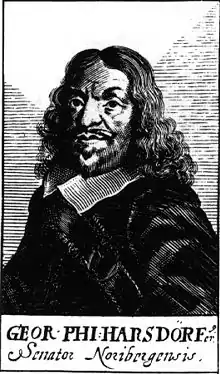Georg Philipp Harsdörffer | |
|---|---|
 Georg Philipp Harsdörffer | |
| Born | 1 November 1607 Nuremberg |
| Died | 17 September 1658 (aged 50) Nuremberg |
| Occupation | Poet, jurist, encyclopedist |
| Language | German, Latin |
| Education | Law |
| Alma mater | University of Altdorf University of Strassburg |
| Period | Baroque-era Germany |
| Genres |
|
| Literary movement | German Baroque, Nuremberg Poetic School |
Georg Philipp Harsdörffer (1 November 1607 – 17 September 1658) was a Jurist,[1] Baroque-period German poet and translator.
Born in Nuremberg, he studied law at Altdorf and Strassburg. He studied at the University of Strassburg under professor Matthias Bernegger.[2] He subsequently traveled through the Netherlands, England, France and Italy. While he was in Italy, he came into contact with members of learned academies. He shared his desire for reform in literary and linguistic for the improvement of moral and culture of the society.[3]
His knowledge of languages earned him the appellation "the learned."[4] He was well-versed in contemporary French culture and literature.[5] As an innovative poet, he was receptive to ideas from abroad.[3] He is still known for his "Germanizations" of foreign-language terms.[1] As a member of the Fruitbearing Society (Fruchtbringende Gesellschaft) he was called der Spielende (the player). In 1644 jointly with Johann Klaj he founded the Pegnesischer Blumenorden, a literary society, in Nuremberg. He was known by the name Strephon among the members of this order.[4]
His writings in German and Latin fill fifty volumes, and a selection of his poems, which are mostly interesting for their form, can be found in Müller's Bibliothek deutscher Dichter des 17ten Jahrhunderts, vol. ix (Leipzig, 1826). Widmann (Altdorf, 1707) wrote a biography of him.[4]
In his Treatise to Protect the Work on the German Language (1644), he asserted that German ‘speaks with the tongues of nature.'[6]
He was the father of Karl Gottlieb Harsdörffer (1637–1708).[7]
Selected works
- Frauenzimmer Gesprächspiele, 8 Bde. (1641–1649)
- Das geistlich Waldgedicht oder Freudenspiel, genant Seelewig (1644)
- Poetischer Trichter-die Teutsche Dicht- und Reimkunst ohne Behuf der lateinischen Sprache, in VI Stunden einzugießen (1647–1653)
- Hertzbewegliche Sonntagsandachten (1649–1652)
- Der Grosse Schau-Platz Jämmerlicher Mord-Geschichte (1649–1650)
- Der Grosse Schau-Platz Lust- und Lehr-reicher Geschichte (1650–1651)
- Nathan und Jotham (1650–1651)
- Ars Apophthegmatica, 2 Bde. (1655–1656)
 Emblem in his book Icones mortis
Emblem in his book Icones mortis
References
- 1 2 Grasnick, Armin (4 January 2022). Basics of Virtual Reality: From the Discovery of Perspective to VR Glasses. London: Springer Nature. p. 376. ISBN 978-3-662-64201-6. Retrieved 3 March 2022.
- ↑ Flint, Eric (1 October 2007). 1634: The Bavarian Crisis. Wake Forest, North Carolina: Baen Publishing Enterprises. p. NA. ISBN 978-1-618-24608-0. Retrieved 4 March 2022.
- 1 2 Kerth, Thomas (1 September 1996). Life's Golden Tree: Essays in German Literature from the Renaissance to Rilke. Berlin: Camden House. p. 69. ISBN 978-1-571-13080-8. Retrieved 3 March 2022.
- 1 2 3 Chisholm 1911, p. 30.
- ↑ Plotke, Seraina (18 April 2018). Semantic Traces of Social Interaction from Antiquity to Early Modern Times: Historical Conversatio. Berlin: Cambridge Scholars Publishing. p. 69. ISBN 978-1-527-50987-0. Retrieved 3 March 2022.
- ↑ Hirschi, Caspar (8 December 2011). The Origins of Nationalism: An Alternative History from Ancient Rome to Early Modern Germany. Cambridge: Cambridge University Press. p. 112. ISBN 978-1-139-50230-6. Retrieved 4 March 2022.
- ↑ http://www.idc.nl/ead/dsc.php?faid=316faid.xml&c01=all
- This article incorporates text from a publication now in the public domain: Chisholm, Hugh, ed. (1911). "Harsdörffer, Georg Philipp". Encyclopædia Britannica. Vol. 13 (11th ed.). Cambridge University Press. pp. 29–30. This work in turn cites:
- Julius Tittmann, Die Nürnberger Dichterschule (Göttingen, 1847)
- Hodermann, Eine vornehme Gesellschaft, nach Harsdörffers "Gesprächspielen" (Paderborn, 1890)
- T. Bischoff, "Georg Philipp Harsdörffer" in the Festschrift zur 1600 jahrigen Jubelfeier des Pegnesischen Blumenordens (Nuremberg, 1894)
- Krapp, Die asthetischen Tendenzen Harsdörffers (Berlin, 1904).
- S. Taussig, C. Zittel (éds.), Japeta. Édition et traduction, Brepols Publishers, 2010, ISBN 978-2-503-52760-4
- Stefan Manns, Grenzen des Erzählens. Konzeption und Struktur des Erzählens in Georg Philipp Harsdörffers "Schauplätzen". Berlin 2013 (= Deutsche Literatur. Studien und Quellen; 14); ISBN 978-3-05-006424-6 (zugl. Univ. Dissertation, FU Berlin 2010).
External links
![]() Media related to Georg Philipp Harsdörffer at Wikimedia Commons
Media related to Georg Philipp Harsdörffer at Wikimedia Commons